Due to its capacity to enable businesses to quickly design and launch unique websites and mobile apps — without the need for coding — low-code application development continues to gain popularity in the industry.
There may be some misunderstandings about what low-code application development is (and isn’t), like with any newly developing category. In light of this, this piece attempts to give readers more background on the essential features of low-code platforms, how the word differs from other abbreviations used in the industry, and the top 5 benefits of low-code application development.
1. What is low-code application development?
According to Mendix – one of the Market Leaders in the Gartner 2023 Magic Quadrant for Enterprise Low-Code Application Platforms, “Low-code is an application development method that elevates coding from textual to visual. Rather than a technical coding environment, low-code operates in a model-driven, drag-and-drop interface. All development skill levels — professional developers, novice developers, subject matter experts, business stakeholders, and decision makers — can use low-code to build value-driven enterprise business applications.”
The platforms for low-code development, however, are not all created equal. However, they all frequently have these basic characteristics.
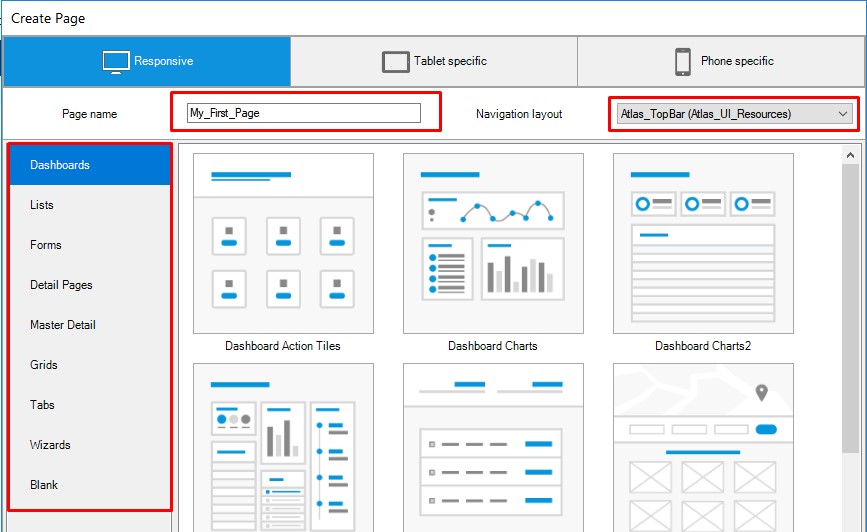
Low-code application development
Source: Mendix
2. Features of low-code platforms
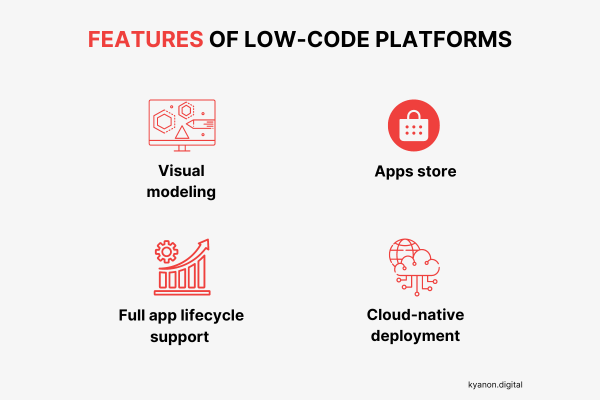
2.1.Visual modeling
Model-driven development (MDD) low-code platforms offer visual models to design an application’s data, business logic, user interfaces, etc.
2.2. App stores
Out-of-the-box templates, widgets, plug-ins, business components, and interfaces to developing technologies are available on low-code platforms with community app stores. Instead of creating something from scratch for every project, creating applications becomes more like graphically assembling the essential building components.
2.3. Full app lifecycle support
The complete application development lifecycle is supported by low-code application development platforms. If there isn’t a fluid means to move apps through the lifecycle, particularly in terms of deployment, the time-to-market benefit of visual development (over hand-coding) is negated.
2.4. Cloud-native deployment
Some low-code platforms also provide you the freedom to manage and deploy your applications on-premises, in private, public, or hybrid clouds, as well as in the cloud of your choosing.
Transform your ideas into reality with our services. Get started today!
Our team will contact you within 24 hours.
3. What are the benefits of low-code application development?
We must take a step back and consider the broader picture in order to comprehend why low-code application development is becoming more popular. There is no shortage of competition in the modern market. With such low entry hurdles, new companies are appearing out of nowhere to disrupt markets with technology-driven goods, services, and business models. Established businesses need to continually develop methods to:
- Think creatively and differently.
- Better, quicker, and less expensive methods should be used.
- Activate your audience in fresh ways.
The following list of 5 advantages of low-code development for enterprises.
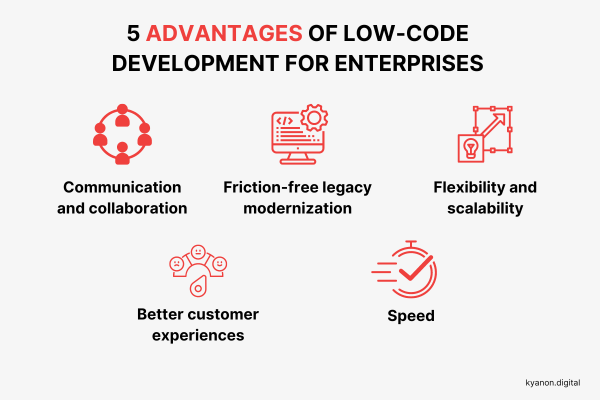
3.1. Communication and collaboration
The core benefit of low-code is that it fosters collaboration between non-technical teams and seasoned developers by using a visual language.
Applications can be designed rapidly, deployed smoothly, and modified with ease by coordinating business, IT, and stakeholders. A higher-quality application and more fruitful business consequences are the end results.
3.2. Friction-free legacy modernization
For projects including digital transformation, legacy modernisation is essential. However, it might be challenging to even consider introducing a new app development platform because old systems are known to consume all organizational IT resources.
It takes a lot of work to begin a legacy modernisation. Low-code reduces the difficulties of dealing with legacy systems and can reduce development time by up to 90%. You may start slowly or jump right in, whether it’s creating new user interfaces or entirely overhauling your system. Low-code helps businesses to create specialized apps that:
- Adapt to current software environments.
- Increase the functionality of your old systems.
- Able to gradually replace outdated systems.
3.3. Flexibility and scalability
Cloud-based low-code platforms provide you the freedom to deploy new apps and make necessary changes to current ones. It is easy and simple for platform users to sign up. Role-based access is implemented by system administrators, who may also manage the entire ecosystem. The potential of low-code apps is greater than that of no-code apps since experienced developers can create unique applications in an IDE.
3.4. Better customer experiences
It’s getting harder and harder to stand out in a crowded market. Being client-centric is essential for survival, and low-code may help you offer reliable, superior digital consumer experiences.
With low-code development, you can easily create customer-facing mobile applications, web portals, IoT-enabled apps, and more on a single platform. The teams closest to your consumers may contribute value by developing applications alone or by collaborating with experienced developers since low-code is collaborative.
3.5. Speed
Faster solution development and delivery is something that everyone wants. The core of every low-code platform is speed, which is achieved with capabilities like visual modeling, pre-built components, automation, one-click deployment, support bots, and built-in monitoring. Low-code can really save the time required for development by up to 90%.
4. What can you build with low-code?
Any employee in your company with a creative concept may utilize low-code to make it a reality, from user interfaces to field service management systems.
Low-code allows you to build:
- Apps for automating and improving processes.
- Portals on the internet for merchants, suppliers, and other parties.
- Native mobile applications and progressive web apps (PWAs).
- Microservices using core systems.
- Smart applications with IoT support.
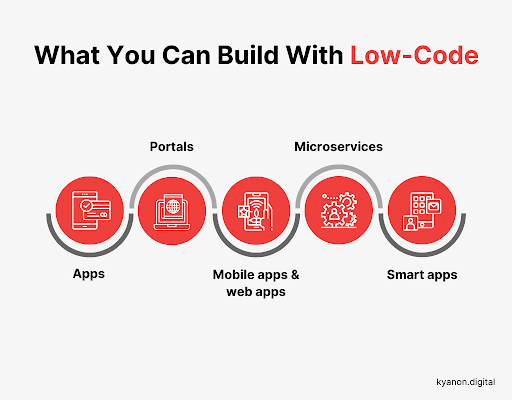
5. How does low-code application development compare to traditional application development?
It’s obvious that conventional development methods can’t keep up with the demand for bespoke apps, which is skyrocketing.
The traditional waterfall application development method necessitates the participation of several individuals in a variety of highly specialized positions. As an illustration, the procedure needs:
- Functional requirements will be created by business analysts.
- These requirements will be transformed into technical specifications by technical analysts.
- To build the database and design the schema, use a database administrator.
- Wireframes and a design will be made by UX/UI developers.
- Developers to build the application and put everything together
Once the application have been built, you then require:
- App testing by testers
- App deployment by an operations manager
- Moving pieces tracking by a project manager
The time it takes to develop an application from the initial requirements to its deployment might be lengthy and there is little opportunity for teamwork. This frequently leads to the end product falling short of what the company had hoped for.
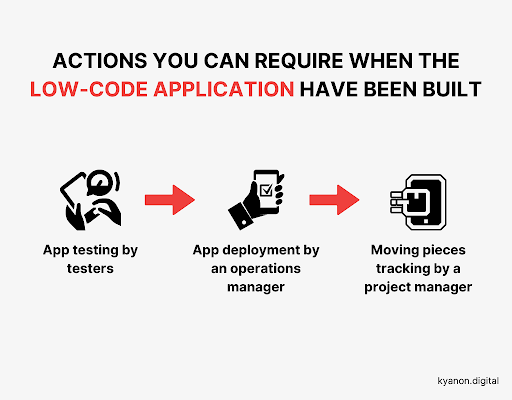
6. How the low-code development process works
Most of the straightforward, repetitive processes you encounter in conventional software development are automated with low-code development.
A technical analyst is not necessary in the absence of the development team since there is no need to transform the requirements into technical specifications. Some low-code systems, like Mendix, already have automated testing and consistency checking features built in, so they don’t require any more technical testers.
Additionally, without all of those individuals, a professional project manager is not required to keep track of all the shifting priorities and handoffs. Additionally, you don’t have to wait for an operations staff member to manually construct the environments and deploy the application with each release thanks to one-click deployment.
This implies that low-code development requires a much smaller team to create an application. The business engineer is more in tune with the company and needs fewer technical abilities. The models provide the company a common visual language that it can understand, fostering tighter business and IT collaboration.
You can provide apps with up to 70% fewer resources if you combine all of these factors. In addition to using fewer resources, you can now produce apps six times faster than you could with conventional development.
The goal of low-code software development goes beyond just accelerating construction. Additionally, offering the ideal application and reducing time to value are important. Because of the common language and capacity to collaborate that low-code development offers, low-code development ensures the success of the app since the person creating it and the person who requires the app can work closely together.
In order to provide apps more quickly, organizations need to. The use of low-code development platforms offers a tried-and-true method for speeding up the creation of new apps. Leaders in IT and business should carefully assess available platforms and select the strategy that best suits the present and long-term demands of their firm.

How the low-code development process works
Source: Mendix
We hope this article has provided you with a lot of useful information about 5 benefits of low-code application development. Kyanon Digital is currently a solution partner of Mendix – one of the leading low-code solution platforms in the world. Kyanon Digital helps accelerate the digital transformation for customers by providing excellent low-code solutions from Mendix. If you are in need of accelerating the development of applications and expanding the business ecosystem, please contact us immediately for the earliest advice.


















